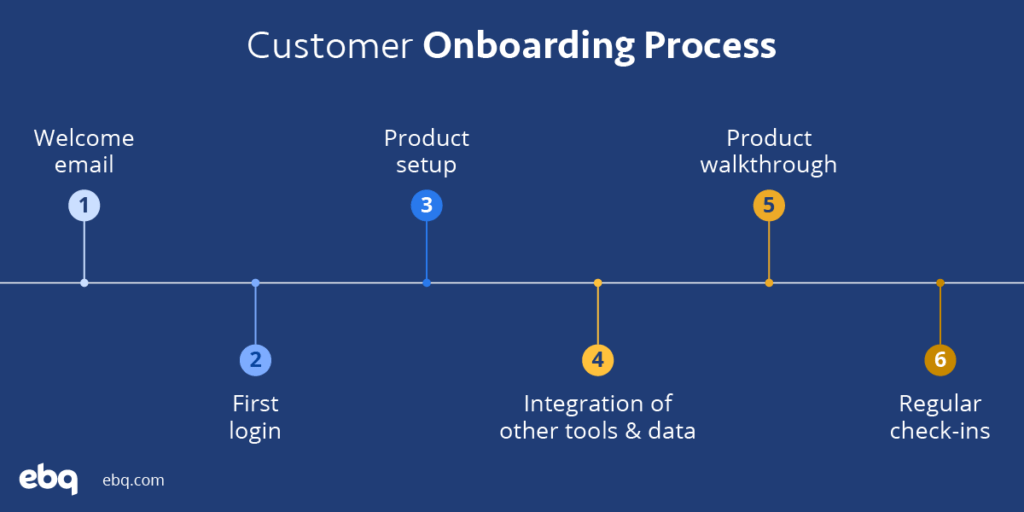How can you ensure that your new clients are taking full advantage of your products and services from the beginning? By properly implementing a customer onboarding process.
An effective B2B onboarding process has additional benefits:
- Sets the tone for your relationship with them
- Increases customer lifetime value
- Reduces churn
- Turns new users into loyal fans
As you read this chapter, you will gain a deeper understanding of the onboarding process and how to make it a smoother transition for your new clients.
In this chapter, you will learn:
- Goals for an effective onboarding process
- Onboarding roles and responsibilities
- Onboarding process steps
Before you get started on the steps for the process, it’s important to set some goals.

The Ultimate Guide to B2B Customer Service Strategy
Learn how to turn customers into brand advocates using our free customer service strategy guide.
Goals for an effective B2B customer onboarding process
Before you create the ideal onboarding process for your customers, it’s key to set goals you want accomplished through the process.
There are 3 goals you should keep in mind when building your onboarding process:
- Have them repeatedly use it the first week
- Establish a pattern of usage
- Make your product necessary
Your onboarding process won’t get far without setting these specific goals.
Goal 1: Repeated use in the first week
Why is it important for your customers to use your product so many times right out of the gate? To build up familiarity.
There’s an old adage that says, “practice makes permanent.” The same saying applies to your customers. That first week is crucial because the sooner they learn how to use the product the sooner they can fully utilize it.
However, you can’t expect them to use your product without a little assistance. During that first week, create touchpoints reminding them to start using the software. Personalized touchpoints are always the strongest, so we suggest reaching out directly over phone or email.
For SaaS (software-as-a-service) products, it can be effective to have automated touchpoints based on usage to help free up your team’s time.
Goal 2: Establish a pattern of usage
Another goal you’ll want to achieve when creating your onboarding process is for your customer to establish a pattern for using your product. This means helping your client get in the habit of using the product and discover where it fits into their day-to-day work.
You can do this by assisting your client in scheduling times when they will work with the product. This is geared more towards using the product during certain points of the customer’s process. For example, have your customer plan to take advantage of your product once they begin to work on a certain task.
Keep in mind the importance of establishing a pattern of usage. Without a set pattern, they may revert back to the way they were doing things before, or worse, use a previous solution from one of your competitors. You need to help break their habit of using their old methods by replacing them with a pattern of using your product.
Goal 3: Make your product necessary
Lastly, through your process, show your client how it can become an integral part of their business. You want your onboarding process to show how they can be successful and improve business outcomes.
One way to show that vision is by talking about your organization’s own experience using the product. If this isn’t applicable to your company, highlighting success stories and use cases from other customers can achieve the same effect.
If you are able to achieve the first two goals, then accomplishing this last goal will be much easier. As they continually use your solution over a span of time, they will continue to realize how important your product is to their success. This will help when it comes time for your client to renew their partnership with you.
Strive to keep each of these goals at the forefront when implementing your customer onboarding process. In order to achieve these onboarding goals, you need to put the right people in the right roles.
B2B onboarding roles and responsibilities
As mentioned in the previous chapter, there are different members that make up your customer service team. In this section, we will focus on the onboarding specialist and the customer consultant since they both play integral parts in the onboarding process.
Customer onboarding specialist responsibilities
Your customer onboarding specialists are like training wheels on a bike. Your customer onboarding specialists are there to support your clients until they have enough foundational knowledge to use the products on their own. The onboarding specialist’s most important task is to get your customer on the right track to take full advantage of their new product.
Customer onboarding specialists have a variety of responsibilities to ensure your clients have a smooth transition into their newly purchased software.
1. Provide detailed directions
Have your onboarding specialists give detailed directions and lay out a roadmap for using your solution. Don’t assume your customers know certain features or benefits.
When it comes to detailed directions, it helps to have an agenda during this time. For example, it’s best to establish an onboarding curriculum with specific milestones and material to leave with them at the end of the session.
It’s also important to take baby steps with them. Don’t expect them to learn everything in one session. Implementing a new product takes time with frequent visits.
2. Collaborate with customers
During the beginning stages of implementation, your client may come across issues or questions. These issues should be addressed immediately by your onboarding specialists.
An onboarding session shouldn’t be a one-way street where your specialist does all the talking. Encouraging your customer to jump in with any questions or concerns can make the experience more engaging and leave a better impression.
Remember, one of the goals is for your customer to have quick success using your product. By tackling these issues as soon as possible, your customer will be able to fully utilize your product that much sooner.
3. Provide a smooth transition
In some instances, the consultant might work with the client before the onboarding specialist if they were the ones to close the sale. Either way, the onboarding specialist will transfer account ownership to the consultant once onboarding is completed. Open communication between the two is critical for a smooth transition.
One method for effective communication is by recording detailed notes about the customer in the CRM through an established process for how each team should use the CRM. This gives visibility and insight that the consultant, or other team members, can leverage to better assist the customer.
Once the customer has been onboarded by the specialist, the consultant will be there to nurture the client.
Customer consultant responsibilities
The customer consultant’s main responsibility is to oversee the entire relationship between the client and the company. From closing the sale to ensuring they are not being neglected later on, the consultant is there to support and nurture the partnership between customer and company.
Along with this main task, the consultant has a variety of other responsibilities during the onboarding stage.
1. Promote the company
While your consultant is communicating with your newly onboarded customers, it is important that they maintain a sales mindset. You want these clients to be long-term customers, not just a one-and-done deal. Continually emphasizing what makes your company different and the benefits you provide will help create longevity and give you a higher chance of being referred to other businesses.
2. Be the voice of the customer
The most effective way to know how to improve both your onboarding experience and services is by going straight to the customer. Since they use your products the most, they may have suggestions for improvement. Your consultant is the one to be the voice for them by gathering feedback about the onboarding process, surveys, reviews, and referrals — and then sharing this data with other departments. This feedback can then be used to improve your product and onboarding process for future clients.
3. Encourage upsells and cross-sells
As your consultant’s relationship with the client grows, they may be aware of other challenges the customer is facing. This is the perfect opportunity to offer other solutions that can benefit their company. For example, we provide full-funnel services — such as lead generation and CRM optimization — here at EBQ. If a company using our lead generation services shares they are struggling with their CRM, our consultant can tell them how our CRM optimization services could help them meet their needs/solve their problem.
As you can see, the responsibilities of these members are important for welcoming a new client. A well thought out onboarding process is another key aspect to help your customers to take full advantage of their new solution.
Steps for a new client onboarding process
With the help of a tailored onboarding process, your customer will have the opportunity to get hands-on experience implementing the product. The right onboarding process allows your client to efficiently learn your product, have a positive experience using it, and recommend it to other businesses.
We recommend following these steps for a customer-friendly onboarding process:

1. Welcome message
Start on the right foot with your new customer by welcoming them aboard. Congratulate them on the new purchase and how excited you are to work alongside them.
Depending on your solution, your consultant may already be in close contact with the customer. The consultant should be guiding the transition from prospect to customer, welcoming them, and providing next steps and resources.
If you have a SaaS-based solution, you may have customers who sign up independently and need to be introduced to your team. You can use tactics like email automation to quickly welcome them and help them get started. Since you want them using this product right away, be sure to have a call to action that nudges them to use the solution.
For example, your automated email could say:
Hi [first name],
Welcome to [product name]!
You’re officially ready to start taking advantage of [product benefit]! Be sure to update your email preferences to get all the latest news and tips about [product name].
Complete your sign in to take your first steps towards success!
Stuck? Our onboarding specialists are here to help you through each step.
[Sign in now]
Best wishes,
[your name] at [company name]
2. Product setup
The onboarding specialist should be heavily involved during this initial setup. This is one of the times when your onboarding specialist should have an agenda prepared for their meeting with the client. The agenda should include detailed instructions for logging in, setting up the product, and the features included in the solution.
We recommend a product setup session should be about 15 minutes to an hour long. This can also be broken up over multiple sessions to keep your customer from becoming overwhelmed.
This is also when you can leave behind educational materials to help them get started with the product outside of your onboarding sessions.
For SaaS customers, we also recommend including instructions inside the platform, such as automated popups explaining features, as well.
3. Integration of other tools and data
Your customer may have other tools, such as other software, that need to be integrated into their new solution. Your onboarding specialist will be there to help with the integration. They may have data that needs to be imported from one product to their new one as well.
Remember, not all companies may have tools and data that needs to be integrated, so you can skip over this step in some cases. But when applicable, these integrations can be critical for making the customer’s new solution fully functional.
4. Product walkthrough
Once their product is set up, it’s time for your client to fully immerse themselves in each feature and aspect of the product. The point of a walkthrough is for your customer to follow steps towards completing key tasks that will give them hands-on experience while being able to ask onboarding specialists questions.
When creating a walkthrough, keep these suggestions in mind:
- Tailor it to how the company will use the tool
- Provide steps for features relevant to their needs
- Include opportunities for continuous learning about the product
5. Regular check-ins
Lastly, show your customers that you care through frequent check-ins from your consultant. Address any issues they are facing and if they are getting stuck anywhere. Allow your consultant to show how they can get more value from your solution.
You can follow up with your customer through emails, phone calls, and video calls. All that matters is that you show you are there for them. Don’t forget to respond quickly! You don’t want to make your customers think you don’t care about them by taking days or weeks to respond.
With a surefire onboarding process like this, you customers will have a more efficient time learning their new product and a higher retention rate.
Optimizing each step in the customer onboarding process
Congratulations! You now know what it takes to create a successful customer onboarding process. Properly trained onboarding specialists and customer consultants are key members of the process, while having a thorough process is just as crucial.
With the skills needed to help clients create their own onboarding process, EBQ’s customer service team has years of experience onboarding new clients to any company’s products and services.

The Ultimate Guide to B2B Customer Service Strategy
Learn how to turn customers into brand advocates using our free customer service strategy guide.


